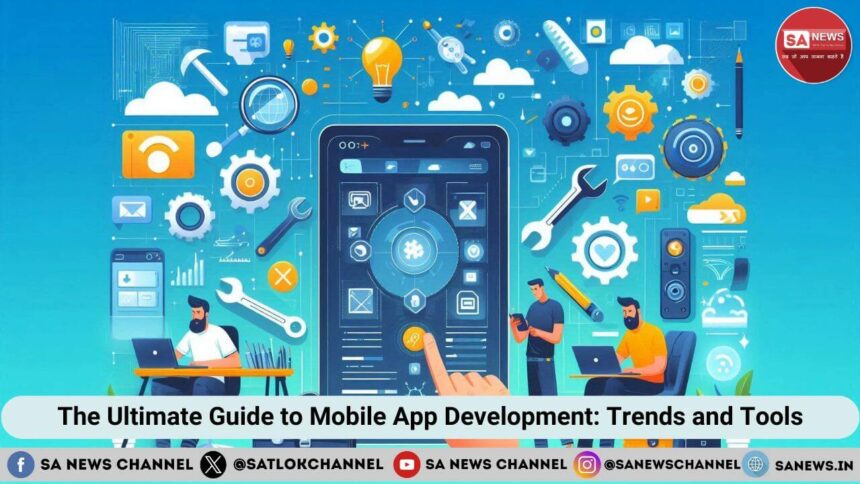Imagine a world where the power to connect, create, and innovate fits in the palm of your hand. A world where your smartphone isn’t just a device, but a gateway to endless possibilities. This isn’t science fiction—it’s the reality of mobile app development. But what exactly goes into crafting these digital marvels that have become an integral part of our daily lives? Let’s embark on a journey through the fascinating landscape of mobile app development, where creativity meets technology, and ideas transform into the apps that shape our digital experiences.
- The Mobile Revolution: Why App Development Matters
- Understanding the Mobile App Ecosystem
- App File Extensions for Android and iOS
- The Mobile App Development Process
- Android App Development: The Open-Source Giant
- Key Features of Android Development
- Key Features of iOS Development
- Cross-Platform Development: Bridging the Gap
- Popular Cross-Platform Frameworks
- Pros and Cons of Cross-Platform Development
- Emerging Trends in Mobile App Development
- Emerging App Categories
- Best Practices for Mobile App Development
- Privacy and Data Protection in 2024
- Top 10 Mobile App Development Tools for 2024
- The Role of AI in App Development
- Conclusion
- Beyond Apps: Embracing Spiritual Wisdom
- FAQs about Mobile App Development
- 1. Q: What is edge computing in mobile app development?
- 2. Q: How do Progressive Web Apps (PWAs) differ from native apps?
- 3. Q: What are super apps?
- 4. Q: How does Kotlin Multiplatform Mobile (KMM) work?
- 5. Q: What is the difference between APK and AAB files in Android?
- 6. Q: What are decentralized apps (dApps)?
- 7. Q: How does AI-assisted coding benefit app developers?
- 8. Q: What are app privacy labels?
- 9. Q: How does 5G technology impact mobile app development?
- 10. Q: What is meant by “on-device processing” in mobile apps?
- 11. Q: How do citizen science apps work?
- 12. Q: What are digital identity apps?
The Mobile Revolution: Why App Development Matters
The mobile app sector has grown rapidly in the past decade. With over 6.8 billion smartphone users worldwide as of 2023, mobile apps have become the primary way people interact with digital services. From ordering food to managing finances, from entertainment to education, mobile apps have revolutionized how we live, work, and play.
This digital transformation has created a massive market opportunity. In 2023, global mobile app revenues reached $565 billion, and this figure is projected to surpass $700 billion by 2025. For businesses, having a strong mobile presence is no longer optional—it’s a necessity for survival and growth in the digital age.
Understanding the Mobile App Ecosystem
Before diving into the development process, it’s crucial to understand the two dominant platforms in the mobile app world: Android and iOS. While there are other operating systems, Android and iOS collectively account for over 99% of the global smartphone market share.
| Platform | Market Share | App Store | Programming Languages |
| Android | 71.8% | Google Play Store | Java, Kotlin |
| iOS | 27.2% | Apple App Store | Swift, Objective-C |
Each platform has its unique characteristics, development tools, and user base. Android, being open-source, offers more flexibility and is used by a wide range of device manufacturers. iOS, on the other hand, is known for its streamlined ecosystem and higher average revenue per user.
App File Extensions for Android and iOS
Android apps use APK (.apk) and AAB (.aab) files. APKs are standard packages containing the app’s code, resources, and manifest, directly installable on devices. AABs, on the other hand, are optimized bundles used by Google Play to generate device-specific APKs, reducing download sizes.
Also Read: Business Automation Tools: Why Do We Crave To Do Less?
iOS apps use IPA (.ipa) files, which package the app’s executable, resources, and code signature for App Store distribution. The .app bundle is used during development, while IPAs are for final distribution. Both platforms enforce strict signing and security protocols to ensure the integrity of apps before they reach users, ensuring a secure and optimized experience for app deployment and usage.
The Mobile App Development Process
Developing a successful mobile app involves several stages, each crucial to creating a product that meets user needs and business objectives. Let’s break down this process:
1. Ideation and Planning: Every great app starts with an idea. This phase involves market research, defining your target audience, and outlining the app’s core features and functionality.
2. Design: User experience (UX) and user interface (UI) design are critical in mobile app development. This stage focuses on creating intuitive, visually appealing interfaces that engage users.
3. Development: This stage involves the actual process of coding. Developers bring the app to life using platform-specific programming languages and tools.
4. Testing: Rigorous testing is essential to ensure the app functions correctly across different devices and scenarios. This encompasses unit testing, integration testing, and user acceptance testing.
5. Deployment: Once the app passes all tests, it’s submitted to the respective app stores for review and publication.
6. Maintenance and Updates: The work doesn’t end with deployment. Regular updates, bug fixes, and feature enhancements are necessary to keep the app relevant and functional.
Android App Development: The Open-Source Giant
Android, created by Google, is the most widely used mobile operating system in the world. Its open-source nature has led to widespread adoption by device manufacturers, resulting in a diverse ecosystem of devices with varying specifications.
Key Features of Android Development
1. Programming Languages: Java has long been the primary language for Android development. However, Kotlin, a more modern language, has gained significant popularity since Google announced first-class support for it in 2017.
2. Development Environment: Android Studio serves as the official Integrated Development Environment (IDE) for Android. It offers a wide range of tools for coding, debugging, and testing Android applications.
3. Fragmentation: The diversity of Android devices can be both a blessing and a challenge. Developers need to ensure their apps work across a wide range of screen sizes, resolutions, and hardware specifications.
4. Google Play Store: This is the primary distribution platform for Android apps. While it’s relatively easy to publish an app on the Play Store, standing out among millions of apps can be challenging.
iOS App Development: The Apple Ecosystem
iOS, developed by Apple, powers iPhones and iPads. While it has a smaller market share compared to Android, iOS users tend to spend more on apps, making it an attractive platform for developers.
Key Features of iOS Development
- Programming Languages: Swift is the modern language for iOS development, introduced by Apple in 2014. It’s more concise and safer than its predecessor, Objective-C, which is still used but less common in new projects.
- Development Environment: Xcode is Apple’s IDE for iOS development. It’s comprehensive and well-integrated with Apple’s ecosystem but only runs on macOS.
- Design Guidelines: Apple places a strong emphasis on design consistency. The Human Interface Guidelines provide detailed specifications for creating apps that feel native to iOS.
- App Store: Apple’s App Store is known for its rigorous review process, which can lead to longer approval times but generally results in higher-quality apps.
Cross-Platform Development: Bridging the Gap
While native development for each platform offers the best performance and access to platform-specific features, it can be resource-intensive to maintain separate codebases for Android and iOS. Cross-platform development frameworks aim to solve this problem by allowing developers to write code once and deploy it on multiple platforms.
Popular Cross-Platform Frameworks
The cross-platform development scene has evolved significantly. Here’s an updated comparison of popular frameworks:
| Framework | Language | Performance | Learning Curve | Community Support | Latest Features |
| Flutter | Dart | Excellent | Moderate | Very Large | Impeller rendering engine, WASM support |
| React Native | JavaScript | Very Good | Moderate | Large | New architecture with JSI, Fabric |
| Kotlin Multiplatform Mobile | Kotlin | Excellent | Steep for iOS | Growing | Compose Multiplatform UI |
| SwiftUI + Kotlin | Swift/Kotlin | Excellent | Steep | Growing | Native performance, shared logic |
Pros and Cons of Cross-Platform Development
| Pros | Cons |
| Faster development time | Slightly lower performance compared to native apps |
| Single codebase for multiple platforms | Limited access to platform-specific features |
| Cost-effective for multi-platform deployment | Dependency on third-party tools and libraries |
| Easier to maintain and update | Potential for inconsistent user experience across platforms |
Emerging Trends in Mobile App Development
The mobile app development landscape is constantly evolving. Here are some trends shaping the future of the industry:
1. 5G Technology: The rollout of 5G networks is enabling faster data transfer and lower latency, opening up new possibilities for mobile apps, especially in areas like augmented reality (AR) and virtual reality (VR).
2. Artificial Intelligence and Machine Learning: AI and ML are being integrated into apps to provide personalized experiences, predictive text, voice assistants, and more.
3. Internet of Things (IoT): Mobile apps are increasingly serving as control centres for IoT devices, from smart home appliances to industrial sensors.
4. Augmented Reality and Virtual Reality: AR and VR technologies are creating immersive experiences in gaming, education, and retail apps.
5. Progressive Web Apps (PWAs): These web applications provide a native app-like experience in the browser, blurring the line between web and mobile apps.
6. Blockchain and Cryptocurrency: Mobile apps are at the forefront of bringing blockchain technology and cryptocurrencies to mainstream users.
7. AI-Powered Personalization: In 2024, we’re seeing AI being used to create hyper-personalized app experiences. Apps now adapt their interfaces, content, and functionality based on individual user behaviour, preferences, and even emotional states detected through facial recognition and voice analysis.
8. 5G and Edge Computing Synergy: With 5G networks becoming more widespread, edge computing is now a reality for mobile apps. This combination allows for near-instantaneous data processing and response times. Gaming apps, in particular, are leveraging this technology to offer console-quality graphics and gameplay on mobile devices.
9. Advanced Biometrics: Biometric authentication has evolved beyond fingerprints and facial recognition. The latest mobile apps are incorporating advanced biometrics such as behavioural patterns, gait analysis, and even cardiac rhythm signatures for enhanced security and personalized user experiences.
10. Sustainable App Development: Environmental concerns are influencing app development. Energy-efficient coding practices, green hosting solutions, and apps designed to promote sustainable behaviours are gaining traction. Some app stores now feature badges for apps that meet certain sustainability criteria.
11. Web3 and Decentralized Apps (dApps): The rise of Web3 technologies is impacting mobile app development. Decentralized apps (dApps) running on blockchain networks are becoming more common, offering enhanced privacy, security, and user ownership of data. Mobile wallets for cryptocurrencies and NFTs are increasingly integrated into mainstream apps.
12. Super Apps: Following the success of super apps in Asia, Western markets are seeing the emergence of all-in-one platforms that combine multiple services within a single app ecosystem. These super apps aim to be the one-stop solution for users’ daily digital needs, from messaging to shopping to financial services.
Emerging App Categories
New types of mobile apps are gaining prominence in 2024:
1. Mental Health and Wellness Apps: With increasing focus on mental well-being, apps offering therapy, meditation, and mood tracking are seeing unprecedented growth.
2. Virtual and Augmented Reality Social Platforms: As VR and AR technologies become more accessible, social apps that allow users to interact in immersive virtual environments are gaining popularity.
3. Citizen Science Apps: These apps allow users to contribute to scientific research through their smartphones, from tracking wildlife to monitoring air quality.
4. Digital Identity Apps: With the rise of digital identities and verifiable credentials, apps that securely store and manage digital IDs, passports, and other official documents are becoming essential.
5. Climate Tech Apps: Applications focused on helping users reduce their carbon footprint, from optimizing energy use to suggesting sustainable lifestyle choices, are on the rise.
Best Practices for Mobile App Development
Regardless of the platform or framework you choose, following these best practices can help ensure the success of your mobile app:
1. Focus on User Experience: Design your app with the user in mind. Intuitive navigation, fast load times, and responsive design are crucial.
2. Enhance Performance: Mobile users demand apps that are fast and highly responsive. Optimize your code, minimize network requests, and use efficient data storage techniques.
3. Ensure Security: Protect user data by implementing robust security measures, including encryption, secure authentication, and regular security audits.
4. Plan for Offline Functionality: Not all users will have constant internet connectivity. Design your app to provide value even when offline.
5. Implement Analytics: Use analytics tools to gather insights about user behaviour and app performance. This data is crucial for ongoing enhancement and refinement.
6. Regular Updates: Keep your app fresh with regular updates, bug fixes, and new features based on user feedback and changing market needs.
7. Accessibility: Design your app to be usable by people with disabilities. This not only expands your user base but is also a legal requirement in many jurisdictions.
Privacy and Data Protection in 2024
Privacy concerns continue to shape the mobile app landscape:
1. App Privacy Labels: Both Google Play and Apple App Store now require detailed privacy labels, giving users clear information about data collection practices.
2. On-Device Processing: More apps are processing sensitive data directly on the device to enhance privacy and reduce data transfer.
3. Privacy-Focused Analytics: New analytics tools that prioritize user privacy while still providing valuable insights to developers are gaining adoption.
Top 10 Mobile App Development Tools for 2024
In 2024, several platforms and frameworks stand out, providing developers with powerful features for building cross-platform and native apps. Here’s a look at the top 10 mobile app development tools that are leading the way this year.
1. React Native: A popular framework by Meta, allowing developers to build cross-platform apps using JavaScript and React.
2. Flutter: A UI toolkit developed by Google that enables the creation of natively compiled applications for mobile, web, and desktop platforms from a single codebase.
3. Xamarin: A Microsoft framework that uses C# for creating cross-platform mobile apps with native performance.
4. SwiftUI: Apple’s framework for building iOS apps, offering a modern way to declare user interfaces.
5. Kotlin Multiplatform Mobile (KMM): A tool by JetBrains enabling shared code for Android and iOS apps.
6. Ionic: An open-source SDK for hybrid app development using web technologies like HTML, CSS, and JavaScript.
7. Apache Cordova: Allows building mobile apps using web technologies, packaging them as native apps.
8. Unity: Primarily for game development but also used for interactive apps with 2D/3D graphics.
9. Android Studio: Google’s official IDE for Android app development, offering a rich set of features.
10. Xcode: Apple’s IDE for iOS, macOS, and watchOS development, supporting Swift and Objective-C.
The Role of AI in App Development
AI is not just a feature in apps but is now an integral part of the development process itself:
1. AI-Assisted Coding: Tools that use AI to suggest code completions, detect bugs, and even generate entire functions are becoming standard in developers’ toolkits.
2. Automated Testing: AI-powered testing tools can now simulate a wide range of user interactions and device conditions, significantly reducing the time and cost of quality assurance.
3. Dynamic Content Generation: Some apps now use AI to generate personalized content, from workout plans to learning materials, tailored to individual user needs and progress.
Conclusion
The mobile app development landscape continues to evolve at a breathtaking pace, driven by technological advancements and changing user expectations. From AI-powered personalization to the rise of Web3 technologies, the opportunities for innovation are boundless. As we look to the future, mobile apps will continue to play a central role in shaping our digital experiences and solving real-world challenges. The key to success in this dynamic field lies in staying adaptable, embracing new technologies, and always keeping the user at the heart of the development process.
Beyond Apps: Embracing Spiritual Wisdom
As we explore the dynamic world of mobile app development, we must also remember the deeper purpose of life. While technology connects us and enhances our daily experiences, it is spirituality that guides us towards true fulfillment. The real “App” we need to develop is within us—the wisdom to understand our life’s purpose, devotion to the True God, and the path to eternal peace.
Books like “Gyan Ganga” and “Way of Living” by Saint Rampal Ji Maharaj provide valuable insights into life’s true essence, showing us the way to achieve spiritual enlightenment and devotion.
FAQs about Mobile App Development
1. Q: What is edge computing in mobile app development?
A: Edge computing processes data closer to the source, reducing latency and improving app performance, especially for real-time applications.
2. Q: How do Progressive Web Apps (PWAs) differ from native apps?
A: PWAs are web applications that offer native app-like experiences through browsers, without requiring installation from app stores.
3. Q: What are super apps?
A: Super apps are all-in-one platforms that combine multiple services (messaging, shopping, financial services) within a single app ecosystem.
4. Q: How does Kotlin Multiplatform Mobile (KMM) work?
A: KMM allows developers to share code between Android and iOS platforms while writing platform-specific UI code.
5. Q: What is the difference between APK and AAB files in Android?
A: APK is a ready-to-install app package, while AAB is an optimized format that Google Play uses to generate device-specific APKs.
6. Q: What are decentralized apps (dApps)?
A: Apps are applications that run on blockchain networks, offering enhanced privacy, security, and user data ownership.
7. Q: How does AI-assisted coding benefit app developers?
A: AI-assisted coding tools suggest code completions, detect bugs, and can generate functions, speeding up development and reducing errors.
8. Q: What are app privacy labels?
A: App privacy labels are required disclosures in app stores that inform users about an app’s data collection and privacy practices.
9. Q: How does 5G technology impact mobile app development?
A: 5G enables faster data transfer and lower latency, allowing for more complex, real-time features in mobile apps.
10. Q: What is meant by “on-device processing” in mobile apps?
A: On-device processing refers to handling sensitive data directly on the user’s device to enhance privacy and reduce data transfer.
11. Q: How do citizen science apps work?
A: Citizen science apps allow users to contribute to scientific research using their smartphones, such as tracking wildlife or monitoring environmental conditions.
12. Q: What are digital identity apps?
A: Digital identity apps securely store and manage digital versions of official documents like IDs and passports, facilitating online identity verification.









